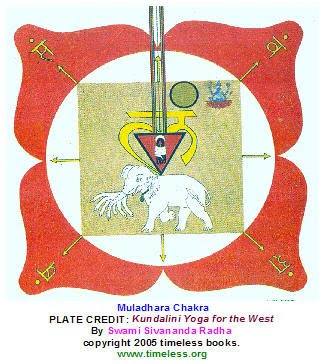The lotus at the base of the sushumna, called the "Root Support" (Muladhara), is described as crimson in hue and having four petals, on each of which a Sanskrit syllable is inscribed (reading clockwise, from the upper right: vam,´sam, sham, and sam). (See fig. 312.) These are to be understood as sound-counterparts of the aspects of spiritual energy operative on this plane. In the white center is a yellow square symbolic of the element earth, wherein a white elephant stands waving seven trunks. This animal is Airavata, the mythic vehicle of Indra, the Vedic king of the gods, here supporting on its back the sign of the syllable lam, "which," Woodroffe writes, "is said to be the expression in gross sound of the subtle sound made by the vibration of forces of this center." 9 The elephant, he continues, is symbolic of the strength, firmness, and solidity of earth; but it is also a cloud condemned to walk upon the earth, so that if it could be released from this condition it would rise. The supervising deity made visible in this lowest center is the world-creator Brahma, whose shakti, the goddess Savitri, is a personification of solar light. On the elephant's back is a downward-pointing triangle symbolic of the womb (yoni) of the goddess-mother of the universe, and within this "city of three sides," this "figure of desire," is seen the first or basal divine phallus (lingam) of the universal masculine principle, Shiva. The white serpent-goddess Kundalini, "fine as the fiber of a lotus-stalk," is coiled three and a half times around this lingam, asleep, and covering with her head its Brahma-door. 10
Now to be exact, the precise locus of this center at the base of the human body is midway between the anus and the genitals, and the character of the spiritual energy at that point is of the lowest intensity. The world view is of uninspired materialism, governed by "hard facts"; the art, sentimental naturalism; and the psychology, adequately described in behavioristic terms, is reactive, not active. There is on this plane no zeal for life, no explicit impulse to expand. There is simply a lethargic avidity in hanging on to existence; and it is this grim grip that must finally be broken, so that the spirit may be quit of its dull zeal simply to be.
One may think of the Kundalini on this level as comparable to a dragon; for dragons, we are told by those who know, have a propensity to hoard and guard things; and their favorite things to hoard and guard are jewels and beautiful young girls. They are unable to make use of either, but just hang on, and so the values in their treasury are unrealized, lost to themselves and to the world. On this level, the serpent-queen Kundalini is held captive by her own dragon-lethargy. She neither knows nor can communicate to the life that she controls any joy; yet will not relax her hold and let go. Her key motto is a stubborn "Here I am, and here I stay."
The first task of the yogi, then, must be to break at this level the cold dragon grip of his own spiritual lethargy and release the jewel-maid, his own shakti, for ascent to those higher spheres where she will become his spiritual teacher and guide to the bliss of an immortal life beyond sleep.~Joseph Campbell The Mythic Image
Chapel Perilous Library
-
http://amzn.to/1Irn6qI http://amzn.to/1GLciOw
http://amzn.to/1LBC3Y9 http://amzn.to/1RRChKu
http://amzn.to/1dvFySc http://amzn.to/1dvG...
10 years ago


























No comments:
Post a Comment